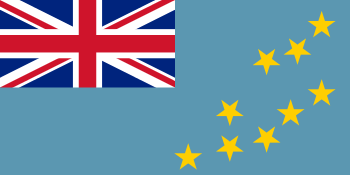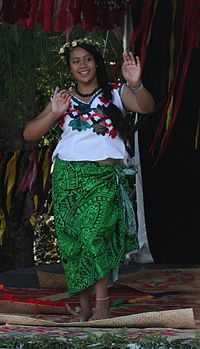Fakaseasea
The fakaseasea is a tradition dance song of Tuvalu. Dancing songs are the most common type of traditional Tuvaluan song, with other tradition dance styles including fakanau and fatele.[1]
Tuvaluan dance music
Dancing songs are the most common type of traditional Tuvaluan song. Older style dancing songs were performed while sitting, kneeling or standing. The two primary traditional dances of Tuvalu are the fakanau (for men) and oga (for women) and the fakaseasea.
The modern fatele involves the women on their feet, dancing in lines; with the men facing the dancers, sitting on the floor beating the time with their hands on the mats or on wooden boxes. [2] [3]
Performance of the fakaseasea
The fakaseasea was mainly performed by women, who were on their feet, dancing and moving their arms, hand and upper body; while men and women would sing and beat the time.[4] It is a slower song with very loose rules on how to dance to it, with variations on different islands with different names. The fakaseasea tradition continues in the present day although performed mainly by elders.
References
- ↑ Linkels, Ad. The Real Music of Paradise. Rough Guides, Broughton, Simon and Ellingham, Mark with McConnachie, James and Duane, Orla (Ed.). p. 221. ISBN 1-85828-636-0.
- ↑ "Tuvaluan Fetele". Jane's Oceania Page. Retrieved 10 April 2014.
- ↑ Linkels, Ad. (2000). 'The Real Music of Paradise (Broughton, Simon and Ellingham, Mark with McConnachie, James and Duane, Orla (Ed.), World Music, Vol. 2: Latin & North America, Caribbean, India, Asia and Pacific ed.). Rough Guides Ltd, Penguin Books. p. 221. ISBN 1-85828-636-0.
- ↑ Koch, Gerd (2000). Songs of Tuvalu (translated by Guy Slatter ed.). Institute of Pacific Studies, University of the South Pacific.
Further reading
- Christensen, Dieter, Old Musical Styles in the Ellice Islands, Western Polynesia, Ethnomusicology, 8:1 (1964), 34-40.
- Christensen, Dieter and Gerd Koch, Die Musik der Ellice-Inseln, Berlin: Museum fur Volkerkunde, (1964)
- Koch, Gerd, Songs of Tuvalu (translated by Guy Slatter), Institute of Pacific Studies, University of the South Pacific (2000)
- Linkels, Ad. The Real Music of Paradise (2000). In Broughton, Simon and Ellingham, Mark with McConnachie, James and Duane, Orla (Ed.), World Music, Vol. 2: Latin & North America, Caribbean, India, Asia and Pacific, pp 218–229. Rough Guides Ltd, Penguin Books. ISBN 1-85828-636-0
- "Tuvalu – Singing and Dancing". Jane's Oceania Page. Retrieved October 21, 2012.
|
|---|
| List of resources about traditional arts and culture of Oceania | | | Art | |
|---|
| | Broad culture | |
|---|
| Geo-specific,
general | |
|---|
| | Canoes | |
|---|
| | Dance | |
|---|
| | Festivals | |
|---|
| | Languages | | by area | |
|---|
| | by category | Languages of Oceania |
|---|
|
|---|
| | Literature | Literature of Oceania |
|---|
| | Sovereign states |
- Australia
- Fiji
- Indonesia
- Kiribati
- Marshall Islands
- Federated States of Micronesia
- Nauru
- New Zealand
- Palau
- Papua New Guinea
- Samoa
- Solomon Islands
- Tonga
- Tuvalu
- Vanuatu
|
|---|
| Associated states
of New Zealand | |
|---|
| Dependencies
and other territories |
- American Samoa
- Christmas Island
- Cocos (Keeling) Islands
- Easter Island
- French Polynesia
- Guam
- Hawaii
- New Caledonia
- Norfolk Island
- Northern Mariana Islands
- Pitcairn Islands
- Tokelau
- Wallis and Futuna
|
|---|
|
|---|
| | Music | |
|---|
| | Mythology | |
|---|
| | Research | |
|---|
| | People | |
|---|
| | Religion | |
|---|
| Not included: Oceanian: cinema, (indigenous) currency, dress, folkore, cuisine. Also see Category:Oceanian culture. |
|

